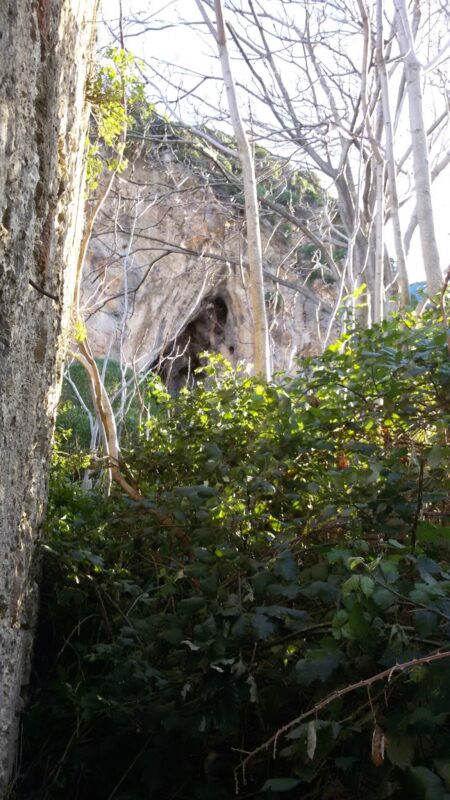Cave of S. Ciro or of the Giants
Behind the church of San Ciro. Upper Paleolithic cave of paleontological interest with rock art
Cadastral number Sicilian caves: n. 20
”Cavity of marine origin open at the foot of Monte Grifone known since the time of Fazello (1558) for the discovery of gigantic bones attributed to giants - according to the Dominican the first inhabitants of Sicily. The cave is now devoid of palethnological and paleontological interest, because it is believed to have been emptied of the ancient filling. In 1949-50, when I visited it for the first time, a good part of the cavity was emptied, rock appeared on the ground in about two thirds of the way. This had a very marked V-section with a very smooth and pitted surface of marine lithophagous organisms. Only in the terminal part, rather dark, was there a filling about the nature of which I would not know how to pronounce. About ten years later, returning to the cave, I found it closed by a wall and a gate; inside there was a tractor parked on a fill of construction waste which, with the memory, I estimate to be about four meters high. The emptying of the cave took place, as for other caves, since the environment was abandoned as a dwelling and it was used as a sheepfold or stable. From that moment on, with the collection of manure to be used as fertilizer for the crops, a small part of the underlying deposit is also collected. Even if each time negligible quantities are subtracted over time they become decimeters and then meters that multiplied by the surface become tens and hundreds of cubic meters. This can lead to the extinction of the deposit, which means erasing the history of the site. Often there is a loss of 3-4 meters of deposit; an extreme case is the Uzzo cave, in the Riserva dello Zingaro, in which there are paleosols about 10 meters from the floor dating back to the Mesolithic period. The anthropozoic deposit of the Grotta di San Ciro probably had to be red earth otherwise it would not have been easy to excavate it. At the beginning of the 800th century, heated disputes about the species and origin of the bones arose among the Palermo scholars. Some were convinced that the bones belonged to different mammals: Elephants,
Deer, Ox, Hippopotamus, etc. Others argued that they would have belonged to the Carthaginian elephants defeated by the Romans in battle around Palermo. Still others attributed the bones of Hippos to those who perished in the games of the supposed Bullfighting that would take place at Maredolce. There are those who claimed that the Hippos had been imported to Sicily by the Arabs and raised in their parks, for the delight of their women, as reported by Domenico Scinà.
In the meantime, these bones were traded and looked for elsewhere for export (Ferrara 1838). The Falconer (1860) refers to the export of 400 quintals to England and Marseille required (non-fossil) by sugar refineries. In 1930 Domenico Scinà was commissioned by the Bourbon government to investigate those bones. New excavations were also carried out in other localities and the fossil nature of the bones attributable to extinct animal species, similar to living ones, is recognized. The Grotta di San Ciro or dei Giganti has today an essentially historical role. In a small cave a dozen meters higher than the Grotta di San Ciro, on the wall there are two small groups of linear engravings. " (Text source: Giovanni Mannino: Guide to the Prehistory of Palermo - List of prehistoric sites in the province of Palermo - Palermo: Sicilian Institute for Political and Economic Studies, 2008.
Bibliography and further in-depth documents:
100) FIRST SICILY - AT THE ORIGINS OF SICILIAN SOCIETY - volume first edited by Sebastiano Tusa Palermo 1997.
198) D. Petruso - V. Forgia - L. Sineo: The human population of Sicily: an interdisciplinary review in the Archive for Anthropology and Ethnology - Vol. CXLIV (2014)
Download file: SINEO et al
200) Gioconda La Magna (edited by) Between Etna and Simeto - Archaeological research in Adrano and its territory - Proceedings of the study meeting for the 50th anniversary of the establishment of the Adrano Museum Adrano, 8 June 2005 - Library of the Regional Province of Catania 2009. Download file: The_Neolithic_in_Valle_del_Simeto
Ignazio Caloggero:
History of Sicily - 1.2. Paleolithic and Mesolithic:
History of Sicily - 1.2.1: Religious sentiments and burials in the Paleolithic and Mesolithic
History of Sicily - 1.2.2: Art in the Paleolithic and Mesolithic
History of Sicily - 1.2.3: Archaeological sites of the Sicilian Paleolithic and Mesolithic
Card insertion: Ignazio Caloggero
Photo: http:// Archivioepensamenti.blogspot.com/2017/05/gli-archi-di-san-ciro-ei-giganti-di.html
Information contributions: Ignazio Caloggero Web,
Note: The populating of the files of the Heritage database proceeds in incremental phases: cataloging, georeferencing, insertion of information and images. The cultural property in question has been cataloged, georeferenced and the first information entered. In order to enrich the information content, further contributions are welcome, if you wish you can contribute through our area "Your Contributions"



